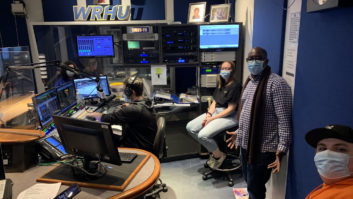This is one in a series of articles about AM radio, its challenges and successes. The first, “Is AM Radio Still Relevant?,” appeared in the Sept. 1 issue.
Not all AM radio stations are struggling.
Arbitron ratings from some of the largest markets in the United States reveal that some AM radio stations in the largest markets are very highly rated. Financial data from BIA/Kelsey, a financial and strategic advisory service, suggest that some are very profitable, too.
Similarly, the same can be said for some small- and medium-market AMs, where local high school sports and agricultural news bring in a lot of local ad dollars.

WHOW in Illinois broadcasts from a barn. Its tower is on the right. Certainly, this is not the first time some radio broadcast observers have spoken of AM radio’s demise. FM’s success in the 1970s changed the radio business landscape, but AM survived. Satellite radio, MP3 players and Internet radio are just the latest technologies trying to topple AM, defenders say.
Without exception, successful AM broadcasters interviewed for this story say they focus on localism and connecting with their communities. Voice-tracking is limited, with local programming favored over syndicated national shows.
An examination by RW of Arbitron ratings of the top 10 radio markets in this country showed that AMs were the top-rated stations for listeners age 6+ in three of the markets, Los Angeles, Chicago and San Francisco, and came in a close second in Atlanta and Boston.
Several large broadcast groups said AM remains profitable for them, even though AMs typically are more expensive to operate than FM broadcast stations.
“I’d encourage people to look across the country at the large number of successful and profitable AM radio stations people are listening to every day,” said Rick Feinblatt, vice president of radio for Greater Media, which operates four AM and 19 FM stations. “I think people tend to focus on only the ones that are not doing well.”
Feinblatt points to the group’s WBT(AM) in Charlotte, N.C., which is solid in the ratings and a profitable station.
“It’s considered the voice of Charlotte, 88 years in format, 50,000 watts that can be heard from Canada to Cuba, and it is focused on localism.”
Bruce Beasely, president and chief operating officer of the Beasely Broadcast Group, said, “Given the many successful news, talk and sports stations across the country and the benefits derived from HD broadcasts, we firmly believe that AM has its place on the dial.”
AM is morphing
His company, which operates 16 AM stations, continues to make prudent, return-focused investments in its AM stations, he said. “We believe those stations still represent an excellent complement to our FM operations.”
WGN(AM) in Chicago is a ratings and revenue juggernaut, according to Arbitron and BIA/Kelsey. The station, which has a 5.6 share for persons 6+ in the Arbitron PPM analysis released in August, is at the top of Chicago radio ratings. BIA Financial Network estimates WGN, a 50,000-watt AM, had revenues of $44.5 million from 2008.
“We all know AM is certainly not a growing medium, but it is morphing into a multimedia tool. AM is what it is. There are limitations to AM, but we deliver the best local content we can, with local expertise and local talent,” said Tom Langmyer, vice president and genera

The Toccoa Junior League All-Stars visit WNEG before they leave for the state tournament. Assistant Manager Todd Mayfield sits at right; the announcer is Connie Gaines, operations manager/morning show host. The WNEG studio can be viewed from the sidewalk and is across the street from railroad depot, visible through window. Photo by Georgia-Carolina Radiocasting l manager of WGN, which is owned by the Tribune Company.
Langmyer contends the future success of AM radio stations depends on reinvention of the product.
“It’s great content on as many platforms as possible. Most great broadcasters realize that. It’s podcasts, it’s social media, the Internet. We use those tools to extend the WGN brand, which just happens to originate on the AM radio dial,” Langmyer said.
WGN, which he said turned off its HD Radio earlier this year because of concerns it was causing interference, broadcasts the Chicago Cubs and Chicago Blackhawks, further identifying with this sports crazy city, Langmyer said.
“We cume a million listeners. This is an AM market if there ever was one. There are a lot of great AM stations here and they drive a lot of people to the AM dial.”
In fact, Chicago’s top two radio stations, at least by one measure, are AMs. CBS Radio’s WBBM(AM) is rated by Arbitron as the second most-listened-to 6+ radio station in the city.
However, good ratings do not always guarantee huge financial success, analysts say.
An indication of how the economy has affected the radio industry is seen in how revenues have fallen for some AM radio stations despite good ratings. The top-rated radio station in San Francisco, Citadel’s KGO(AM), has seen revenue dip just over 21 percent since 2003. BIA/Kelsey estimates that KGO billed $29.4 million in 2008.
WSB(AM) in Atlanta, a solid second in overall Arbitron 6+ PPM ratings in August and the top AM, had revenues of $17.5 million in 2008, down approximately 21 percent from 2003, according to BIA/Kelsey.
Small- and medium-market AM broadcasters, which work with significantly smaller financial numbers, face their own set of challenges, according to several small-market AM radio station owners.
WNEG(AM) in Toccoa, Ga., with a population of 9,000, wins on nearly every front, from ratings to revenue to community acceptance, said Art Sutton Jr., president and chief executive officer of Georgia-Carolina Radiocasting, a group that owns 14 small-market radio stations in Georgia, South Carolina and North Carolina, including seven AM stations.
“Our cornerstone has to be local news. The newspaper here is weekly, so if people want news they listen to us. But it’s more than that. We have a longtime legacy of being information-oriented,” Sutton said. “The station has done local news since it signed on in 1956. I think the AMs that are successful have that kind of legacy and consistency.”
Super-serving the local markets

WNEG’s Charlie Bauder and Buzz Tatham work the Stephens County High School Indian Tailgate Show in the fall of 2008. Photo by Georgia-Carolina Radiocasting The station, 500 watts daytime and 44 watts nighttime on 630 kHz, has $600,000 in annual sales and cash flows nearly half that, Sutton said.
Billing itself as The Voice of Northeast Georgia, WNEG plays some music and has a staff of six full-time and four part-time employees. The station is “part of the fabric” of the community, Sutton added.
“Our employees all serve the community in many different ways, from serving on local boards to running charitable events. They are very well respected in the community.”
Sutton, who has owned the station since 2001, said consistent station ownership over the years is another key to his station’s success.
Three Eagles Communications Inc., founded in 1994 by Rolland Johnson, owns 15 AM radio stations across Iowa, Minnesota, Nebraska and South Dakota.
“It’s the breadbasket of the United States and we are doing very well with all of our AM stations,” said Johnson. “We are local, live and relevant. We take very little syndicated product. Our focus is local news, sports, weather, agriculture, and every now and then we’ll play a song.”
KFOR(AM) in Lincoln, Neb., is the company’s most successful station, Johnson said, but “all are profitable because we are totally in tune with our local markets.
“We are close to a 35 percent profit margin with our AM stations,” Johnson said.
Three Eagles Communications, which purchased several underperforming AM stations from Clear Channel several years ago, believes in providing information to their communities of license when it is convenient to the public and not only when it is convenient to the broadcaster, Johnson said.
“We super-serve the local markets because it is good business. We know people will listen to us and respond to us, which means they’ll advertise on us,” Johnson said.
WHOW(AM) in Clinton, Ill., is in the middle of corn country, so it figures that the station broadcasts a format consisting largely of agricultural news.
“This was a station that was literally off the air in the fall of 2007 and now we are doing very well,” said Randall Miller, president of WHOW.
The station, with a tradition of service to the farming community since 1947, lost its tower in an ice storm in 2006. The 5,000-watt daytimer rebuilt its 325-foot tower in early 2008 after Miller purchased the station and now features a local morning show and several regional ag radio programs.
WHOW, which broadcasts from “the big red barn” at 1520 kHz, is an independent and local radio station, a real slice of Americana, with a long history of serving the surrounding farming communities of central Illinois, Miller said.
Comment on this or any article. Write to[email protected].
Related:
“AM Relevance: Remember the Listener” (Oct. 14)
“10 Steps to Fix AM’s Problems” (Oct. 13)







